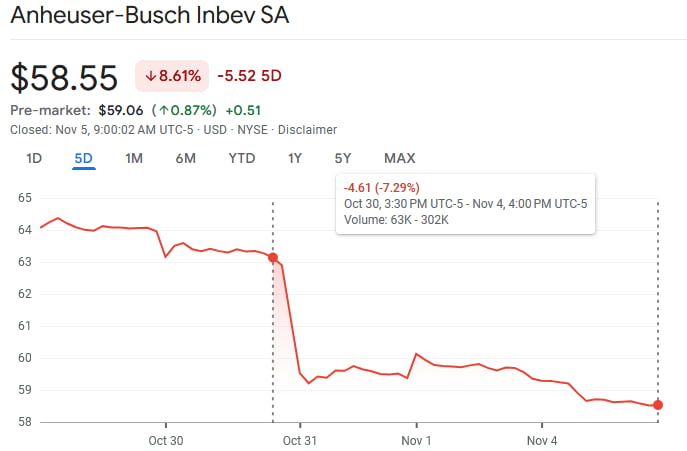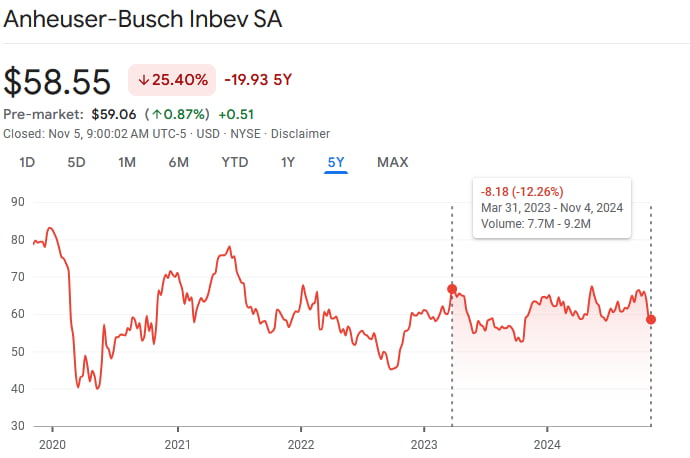Bud Light used to be the number one beer brand in the United States — but has since dropped down to third place. The decline happened due to a widespread boycott following conservative backlash against a marketing campaign that included transgender social media personality Dylan Mulvaney.
The effects of the boycott were immediate and significant — in the month following the airing of the advertisement, sales plummeted by double digits, and estimates from earlier this year peg total losses at a staggering $1.4 billion.
Bud Light’s parent company, Anheuser-Busch InBev (NYSE: BUD), the largest brewer in the world, publicized its Q3 2024 earnings report on October 31. It seems like sales in the U.S. are rebounding — but that fact offers little comfort when compared to the wider picture.
BUD stock drops after earnings
Anheuser’s earnings call was a mixed bag. Earnings-per-share (EPS) came in at $0.98, outpacing consensus estimates of $0.92 and representing a solid 13.95% growth on a year-over-year (YoY) basis.
Revenues, on the other hand, came in short — analysts were expecting to see 3.4% growth, while the final tally was just 2.1%. Volumes also saw a significant 2.4% decline — far worse than consensus expectations of 0.4%.
U.S. figures also suffered — deliveries to wholesalers shrank by 0.2%, while sales to retailers receded by 3%.
On the bright side, the brewing giant did raise guidance, now anticipating EBITDA growth of 6% to 8%, and announced a $2 billion stock buyback program. The company’s Beyond Beer segment also saw modest single digit growth.
But markets remain unconvinced — at the time of publication, BUD shares were trading at $58.55, having shed 7.29% in value since the earnings call. On a year-to-date (YTD) basis, BUD stock is down 8.87%.

Has BUD recovered from the boycott?
The controversy that started BUD’s unexpected fall from the coveted position of America’s favorite beer started on April 1, 2023. A day prior, BUD stock closed at $66.73 — meaning that it is still down 12.26% compared to those prices.

While stock prices have obviously not recovered, Anheuser has made significant strides in terms of optimization. Revenue per hectoliter increased by 1.8% in the United States and 5.2% in the key Brazilian market. Although China remains a significant sore spot due to a soft industry environment, with revenues in that market down 16.1%, on the whole, revenue per HL increased by 4.6%
Readers should note that scale plays a large role — Anheuser accounts for roughly 25% of beer sales worldwide, so a 4.6% increase in revenue per hectoliter is massive. With such a commanding market share and significant gains in terms of efficiency, the price decline from the boycott could actually serve as a great buying opportunity.
At press time, BUD stock is trading at a trailing P/E ratio of 18.30, and a forward P/E ratio of 15.34 — meaning that the biggest brewer on the planet is currently significantly more affordable than the average publicly-traded company.
Featured Image:
Bystrov, Alex Bystrov, Minsk, Belarus — September 30, 2022. Digital Image. Shutterstock.






